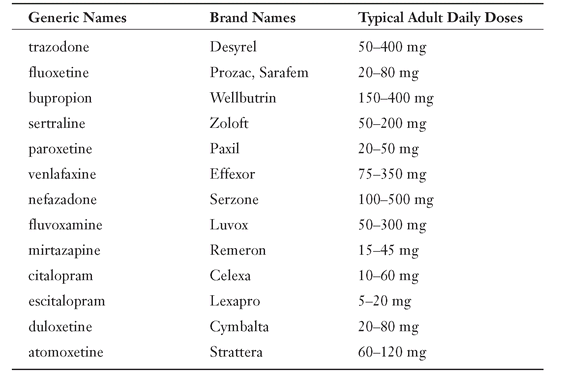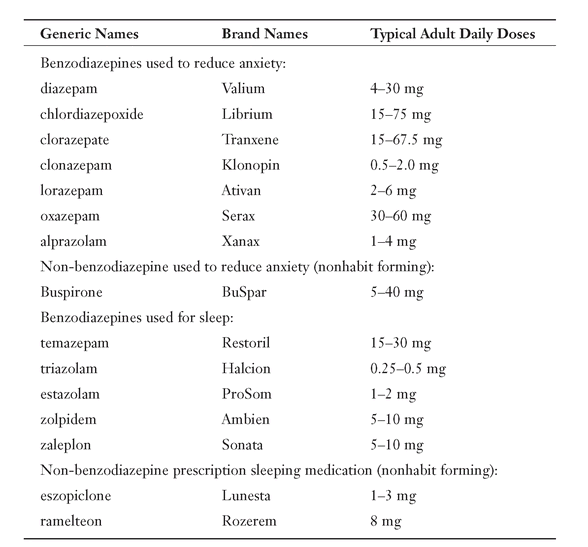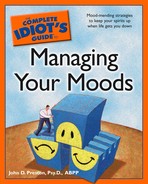Appendix D
Quick Reference Guide to Antidepressant and Antianxiety Medications
Antidepressant and antianxiety medications are among the most widely prescribed medications in our country. When properly prescribed, they can provide considerable help for those who suffer from more severe forms of anxiety and depression. As I have noted in several of the chapters of this book, most prescriptions for these classes of medications are written by primary-care doctors.
While many primary-care physicians are knowledgeable in the treatment of anxiety and depression, two significant problems exist. The first is that often there is grossly inadequate follow-up and not enough time for appropriate patient education. The majority of people treated for anxiety and depression in primary-care settings never take these medications for long enough or at adequate-enough doses for them to be effective. Second, it is always important to combine medication treatment with psychotherapy. Again, in primary-care settings, often there is not a referral made to a psychotherapist.
This appendix addresses many basic questions people have regarding antidepressants and antianxiety medications. The discussion of other classes of psychiatric drugs (e.g. mood stabilizers and antipsychotic medications) is beyond the scope of this book.
Note: To the best of my knowledge, doses and side effects listed below are accurate. However, this is meant as a general reference only and should not serve as a guideline for prescribing medications. Brand names are registered trademarks.
Antidepressant Medications
In the 1950s and 1960s, tricyclic and MAOI antidepressants were discovered. These drugs were found to be effective, but had noticeable side effects and were quite dangerous if taken in an overdose. The antidepressants listed here are often called “new-generation antidepressants,” and have considerably safer side-effect profiles.

Uses: to treat major depression, dysthymia. In addition, the following disorders can be treated by all antidepressants except Wellbutrin, which may increase anxiety: panic disorder, generalized anxiety disorder, social anxiety, and obsessive-compulsive disorder (OCD). Additionally, the following antidepressants may be used to treat premenstrual dysphoric disorder: Prozac, Sarafem, Zoloft, Paxil, Celexa, Luvox, and Lexapro. Antidepressants should be used with caution in treating bipolar disorder. They may aggravate that condition.
Onset of positive effects: generally two to six weeks. Must be taken every day as prescribed. It is often very difficult for people to wait the required several weeks before experiencing noticeable signs of recovery. Unfortunately these drugs do not work quickly, thus patience is required. During the first few weeks of treatment, exercise will generally help to relieve some depressive symptoms until the medication effects begin to emerge.
Note: when antidepressants are used to treat premenstrual dysphoric disorder (PMDD), the positive results are often experienced several hours after taking the first dose. This very rapid onset of actions is only seen in PMDD and not in any other types of depression.
How long must they be taken: generally if there is a positive response to antidepressants, it is advised to keep taking the medications for a minimum of an additional six months to prevent acute relapse. For many people this does not make sense, because they have recovered from the depression, but this additional six months of treatment greatly reduces the likelihood of relapse. For the treatment of PMDD, generally the medications are only taken for the duration of premenstrual symptoms (this varies from one woman to another, but generally are taken only for a few days each month).
Caution if discontinued: all antidepressants, except Prozac, if taken for more than a few weeks must be discontinued gradually. Otherwise, withdrawal effects can be experienced, including nausea, general body aches, occasionally a peculiar electrical shock sensation going through the arms or head (not dangerous, but unpleasant and odd), and anxiety. The symptoms feel like you have the flu. Gradual discontinuation over a period of four to six weeks can prevent such withdrawal symptoms.
Laboratory tests: not required
Common side effects:
• Nausea
• Heartburn
• Energized or anxious feelings; i.e. “activation” (typically subsides within one to two weeks)
• Headaches
• Sedation (primarily with Remeron and Desyrel)
• Difficulty falling asleep (often subsides in a few weeks)
• Sexual dysfunction: primarily inorgasmia (difficulty achieving an orgasm despite adequate arousal); can occur in 14 to 30 percent of people treated with antidepressants. One exception: very rare with Wellbutrin
• Weight gain (primarily with Remeron; with other antidepressants, weight gain can occur in up to 10 percent of people, however, the weight gain typically does not occur until the person has been taking the drug for a period of time longer than six months)
• Muscle tremor
• Rash
Rare side effects (if these occur, patient should immediately contact the treating doctor):
• Soreness of mouth, throat, or gums
• Severe rash
• Seizures
• Unusual bruising or bleeding
• Severe nausea, vomiting, and flu-like symptoms
• Severe agitation or restlessness
• Yellow tinge to skin or eyes; dark-colored urine
• Rapid shift into mania or hypomania; racing thoughts
Habit-forming/addiction potential: none
Interactions with other medications: (varies depending on the drug). Do not take with St. John’s Wort, 5-HTP (dietary supplement), MAOIs, cimetidine (Tagamet).
Safety during pregnancy: most experts agree that some new-generation antidepressants are safe for use during pregnancy (e.g. Prozac, Zoloft, Effexor, Wellbutrin and Luvox); however, recently concerns have been raised regarding the drug Paxil during pregnancy. (Note: the following antidepressants have only recently come to the market and there is inadequate data to evaluate safety during pregnancy: Cymbalta, Strattera, Lexapro, Celexa, Serzone, and Remeron). High doses of Desyrel should not be used during pregnancy.
Breast-feeding: antidepressants are secreted in breast milk, but the amounts are extremely low. Most experts agree that it is safe to breast-feed while taking new-generation antidepressants.
Recent concern regarding antidepressants and increased suicide: there has been a good deal of media attention regarding potential risks of antidepressants and increased suicidality (especially in children and adolescents). The initial concern came from studies in England that raised concerns about increased suicidality in young patients treated with the antidepressant Paxil. In this study, which included 1,300 patients, Paxil was compared to placebo and reports of increased suicidality were seen in 1.2 percent of placebo and 3.4 percent of Paxil-treated subjects. This difference is statistically significant. It is important to note that there were no actual suicides in this group of youngsters and a number of so-called suicidal “events” occurred in the Paxil group when the children stopped taking the medication.
In trying to understand and address this issue, one significant problem is that the concept of “suicidality” has been very loosely defined in this and other studies.
Most times it includes reports of increased thoughts about suicide, suicide gestures, nonlethal-intent self-mutilation (as is often seen in borderline personality disorders), and, in one instance, even a report of a child slapping herself qualified as a suicide attempt. Of course, actual suicides and lethal attempts are also included under this umbrella of suicidality.
Concerns regarding increased suicidality have had a significant impact. Currently the United Kingdom Committee on Safety of Medications has banned the use of all antidepressants for use in patients under the age of 18, with the exception of fluoxetine (Prozac). In the United States, the FDA has also responded to concerns about increased suicidality by requiring drug companies to issue warnings about the use of these drugs with younger clients. They also initiated a study to investigate the data: they are currently evaluating a database of 4,400 teenagers treated with antidepressants and final conclusions are pending. It is interesting to note that in this large group of adolescents treated with SSRIs, there have been no suicides. A recent large study conducted by the National Institute of Mental Health evaluating the effect of antidepressants in the treatment of teenagers with serious depression found a significant decrease in suicidality among those treated with antidepressants. It has also been documented that in geographic areas where antidepressants are in widespread use, suicide rates have dropped among adolescents. This has been reported by the Center for Disease Control and Prevention.
Despite these findings, it must be kept in mind that suicidal thoughts and feelings are common among people with serious depression, and that antidepressants, in some instances, may contribute to an increased risk especially during the first two weeks of treatment. (Note that most of these medications take three to four weeks to become effective in reducing depressive symptoms.) When there is an increase in suicidality during the first few weeks of treatment, any of the following may be contributing factors:
• Activation and increased restlessness (an occasional side effect of starting these medications that typically last from a few days up to 10 days after starting treatment) may add to a general sense of emotional discomfort.
• Antidepressants can provoke dysphoric mania in some people who, in fact, have bipolar disorder.
• Increased energy may occur before a decrease in depressed mood (the person then has the energy to carry out a suicide attempt).
• Noncompliance: most suicide victims who have been prescribed antidepressants are found on autopsy to have little or no traces of antidepressants in their blood, suggesting that they were not, in fact, actually taking the medication at the time of the suicide.
• Patient-initiated discontinuation: there are two common, problematic results that might account for increased suicidality: antidepressant-withdrawal symptoms (mentioned previously) and/or the loss of what had been a positive antidepressant effect, plunging the patient back into depression.
It is also worth noting that the vast majority of people who do, in fact, commit suicide are not receiving any form of psychiatric treatment.
What is clear is that untreated major depression carries significant risks of potential suicide; antidepressants take several weeks of treatment before the first signs of clinical improvement, and depression can worsen during this start-up period of treatment. In evaluating these kinds of concerns, it is always important to differentiate between media hype and scientific data.
Antianxiety Medications
As mentioned, many anxiety disorders are treated with antidepressants. In this section, we’ll discuss other options for treating anxiety. Benzodiazepines are commonly referred to as minor tranquilizers or antianxiety medications.

Uses: to treat anxiety disorders (such as panic disorder, generalized anxiety disorder, social anxiety disorder, and severe situational stress; not generally helpful for OCD or PTSD: these two disorders are more effectively treated with antidepressants) and insomnia.
Onset of positive effects: 30 to 60 minutes. Tranquilizers only stay in the body for a few hours (4 to 12 hours depending on which medication is prescribed). Thus generally they must be taken several times a day.
How long must they be taken? Situational stress, by definition, is time limited, thus medication use may be for only a few days or a few weeks. However, most other anxiety disorders tend to be quite chronic. For this reason, if medications alone are used, people often take the drugs for a period of many years. However, a common and effective approach is to begin with the use of medications but also become involved in psychotherapy. Psychotherapy (as described in Chapters 25 and 26) can afford more long-lasting benefits. Once psychotherapy is effective, often medications can be gradually phased out or the dosage can be reduced.
Laboratory tests: none required
Common side effects:
• Drowsiness
• Dizziness
• Forgetfulness
• Slurred speech
Less common side effects:
• Confusion
• Nervousness
• Rash
• Loss of balance; falling
Habit-forming/addiction potential: significant risk for people with a prior personal or family history of alcoholism or other forms of serious drug abuse. As noted in the preceding table, Lunesta, Rozerem, and BuSpar are nonhabit forming. Also as noted previously, if antidepressants are used, these drugs are not habit-forming.
Interactions with other medications: when taking benzodiazepines, any other type of medication that causes drowsiness or impaired alertness and reaction time can be potentially dangerous, especially if driving an automobile. In addition, alcohol should not be consumed when taking benzodiazepines.
Safety during pregnancy: benzodiazepines typically are not to be used during pregnancy.
Breast-feeding: benzodiazepines are secreted in breast milk and should not be used when breast-feeding.
Special concerns about discontinuation: if benzodiazepines are being taken on a regular basis, the body develops a tolerance for the medication. When this happens, typically the drugs continue to work to reduce anxiety, but the problem is that when tolerance has developed and the drug is discontinued abruptly, withdrawal symptoms result. Withdrawal symptoms usually include nervousness, agitation, difficulty falling asleep, and, on occasion, seizures. This needs to be taken very seriously. If patients have been taking a benzodiazepine on a daily basis for more than six weeks, and especially if the dose is moderate to high, withdrawal reactions are a very real risk. One should never abruptly stop taking the medication without first consulting with their treating physician. It is also a good idea for patients to monitor their supply of the medications so that they can request refills in a timely fashion. Many people find it helpful to keep at least a two-day supply on hand in the event that it takes longer than usual for a prescription to be refilled.
A Final Word About Medications
Despite advances in drug safety and clear benefits for many individuals suffering from more severe depressions or anxiety, all medications have side effects and limitations. Any treatment with psychiatric drugs must be accompanied by psychotherapy. In the words of noted psychiatrist Roy Menninger, “There will never be a pill that can mend broken hearts, fill empty lives, or teach people how to love one another.”
..................Content has been hidden....................
You can't read the all page of ebook, please click here login for view all page.
